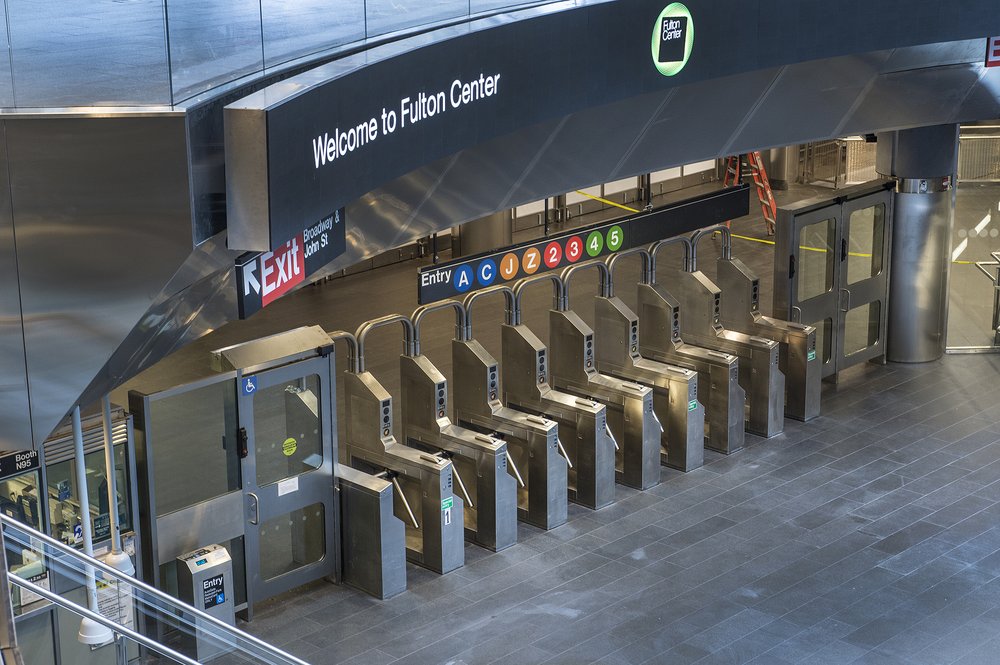MTA was bad landlord at Fulton Transit Center for a decade, Westfield says
March 15, 2024, 1:31 p.m.
According to Westfield, the MTA cut the ribbon on the busy Manhattan transit hub in 2014 and rented out space before construction was even finished.

This column originally appeared in On The Way, a weekly newsletter covering everything you need to know about NYC-area transportation.
Sign up to get the full version, which includes answers to reader questions, trivia, service changes and more, in your inbox every Thursday.
Crime isn’t Westfield’s only issue at MTA’s Fulton Center
Westfield’s move to break its lease at the Fulton Transit Center over a perceived lack of security was the culmination of years of frustration with the MTA that began before the station even opened.
The real estate giant argued in legal filings that “unsafe conditions” gave it grounds to withdraw early from its 20-year deal to manage retail at the Lower Manhattan station. But the filings also reveal that Westfield’s attempt to bail on Fulton Center is just the latest chapter in a nearly decadelong dispute with the MTA. In essence, Westfield argues the MTA is a bad landlord.
The bustling downtown subway station — which connects nine train lines — opened in 2014, seven years behind schedule and more than $600 million over budget.
But according to Westfield, the MTA cut the ribbon on the station and rented out space before construction was even finished.
“Once Westfield came into possession of the premises, it realized that much of the work that was required to be performed by MTA/NYCTA prior to the delivery of the commercial usage areas was incomplete and/or defective,” the company wrote in a Manhattan federal court filing last Friday.
“Despite the ‘target opening date’ in 2014, NYCTA continued its construction work at Fulton Transit Center well into 2016,” the filing states, claiming the agency “strung Westfield along… without any identifiable completion date.”
Westfield attorneys write the MTA “misrepresented floor plans,” failed to pour more than a foot of concrete, and did not build features like a service elevator and employee restrooms.
The company demanded a rent reduction in 2018, citing the unfinished construction. The MTA responded with a lawsuit, and the two sides wound up in arbitration. Records in court show arbitrators ruled in favor of Westfield in 2022, awarding the company more than $13 million in restitution and ordering the MTA to make repairs to the station. The MTA has since appealed that judgment.
MTA spokesperson Joana Flores declined to comment on the ongoing litigation.
Westfield wrote that the MTA’s decision to go to court over the repairs prolonged “several construction and accessibility issues” at the station.
Of course, there’s another factor in Westfield’s effort to break its lease at Fulton Center that has nothing to do with crime. The Paris-based company said in 2022 that it planned to sell all of its shopping mall properties in the United States.
This week in New York City transit news
Listen here:
Former law enforcement officials said the 750 National Guard soldiers Gov. Kathy Hochul deployed to help check riders’ bags in the subways are ill-equipped to actually prevent violence. “Nobody is carrying a weapon in a bag that’s subject to search,” said one former NYPD officer and National Guardsman. Read more.
The last time the military was seen in the subway system in large numbers was after 9/11 and during a mission to rescue commuters trapped on trains during a blackout in November 1965. Read more.
A new NYPD Plate Task Force is being deployed once a month to crack down on the fake and altered license plates that are increasingly being used to evade tolls. Read more.
LaGuardia Airport, once considered among the ground-dwellers of North American airports, is now one of the best in its class, according to the new Airport Service Quality survey. Read more.
City Council Speaker Adrienne Adams wants to expand eligibility for half-priced transit fares to New Yorkers whose income is double the national poverty line. (Streetsblog)
The New York Times asked several city agencies if they’re doing anything to stop migrant children from selling candy in the subways during school hours. No one said “yes.” (The New York Times)
Open Streets in wealthier, more volunteer-heavy neighborhoods are expected to close or shorten their operating hours this summer due to a lack of resources. (Curbed)
Curious Commuter
Question
Will there ever be a train to Red Hook?
–Neil Mullen, Brooklyn
The MTA considered extending the W train to Red Hook in its 20-year needs assessment, which was released last year. That’s the document the agency uses to prioritize projects to spend money on in the coming years.
Unfortunately for commuters like Neil, that project scored low in nearly every category. The report estimated that only 7,600 daily riders would use the extension, which is small on the MTA scale. For comparison, the MTA estimates that 239,700 riders would use its plan to extend the Second Avenue subway across 125th Street from Lexington Avenue to Broadway. Extending the W train to Red Hook and building three new stations would cost more than $11 billion, while the proposed extension of the Second Avenue subway would cost a mere $7.5 billion, according to MTA estimates.
The Red Hook line would also be a technically complex project that would require the MTA to break through the cast-iron lining in the tube currently used by the R and W trains. In addition, the MTA doesn’t want to get in the way of future construction on the BQE.
It’s also a pain because the MTA does not own a third of the land it would need to build the extension, so acquiring the real estate drives up the cost. In other words, don’t hold your breath for a train to Red Hook.
Retail giant Westfield says crime at MTA's Fulton Transit Center is forcing it out